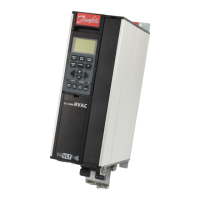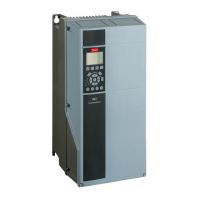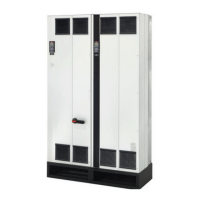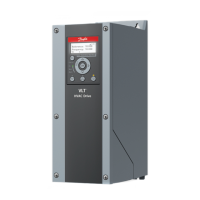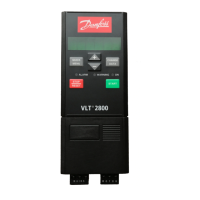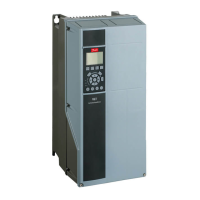VLT
®
6000 HVAC
MG.60.B1.02 - VLT is a registered Danfoss trademark
10
■■
■■
■ Better regulation
If a frequency converter is used for regulating the flow
or pressure of a system, improved regulation is
obtained which can be adjusted very precisely.
A frequency converter can vary the speed of the fan or
pump infinitely, thereby obtaining infinitely variable
control of flow and pressure.
Furthermore, a frequency converter can quickly
regulate the speed of the fan or pump, so as to adapt
it to new flow or pressure conditions in the system.
More traditional, mechanical flow or pressure
regulating systems tend to provide slow, inaccurate
regulation if compared with that of the frequency
converter.
■■
■■
■ Frequency converters generate less noise
If the speed of a fan is changed, the sound level
changes, too. If the rpm figure is reduced by 50%
from the rated rpm value, the sound level will go down
by approx. 16 dB(A).
The formula is:
55 log x ( ) = dB(A)
■■
■■
■ Simpler installation when using a frequency con-
verter
A frequency converter can replace a traditional
regulating system, in which mechanical dampers and
valves are used for regulating flow or pressure.
The great advantage involved in using a frequency
converter is that the system becomes simpler, since a
lot of the mechanical and electrical equipment is no
longer required.
■■
■■
■ V-belts no longer required
In mechanical regulating systems, where the fan is
driven by V-belts, it is necessary to change belt
pulleys in order to adjust the fan speed to match the
neces-sary maximum load. Using a frequency conver-
ter, the V-belts can be replaced by directly driven mo-
tors, whose speed is changed simply by means of the
frequency converter.
The efficiency of the system improves and the entire
installation takes up less space. There is no dust from
the V-belt and less maintenance.
■■
■■
■ Regulating dampers and valves no longer
required
Since the flow or pressure can be regulated by
means of the frequency converter, no regulating
dampers and valves are required in the system.
■■
■■
■ Cos
ϕϕ
ϕϕ
ϕ compensation
Generally speaking, a frequency converter with a cos
of 1 provides power factor correction for the cos ϕ of
the motor, which means that there is no need to
make allowance for the cos ϕ of the motor when
sizing the power factor correction unit.
■■
■■
■ Star/delta starter or soft-starter not required
When larger motors are started, it is necessary in
many countries to use equipment that limits the
start-up current. In more traditional systems, a star/
delta starter or soft-starter is widely used. Such
motor starters are not required if a frequency conver-
ter is used.
As illustrated in the figure below, a frequency conver-
ter does not consume more than rated current.
1 = VLT 6000 HVAC
2 = Star/delta starter
3 = Soft-starter
4 = Start directly on mains
■■
■■
■ Cost of using frequency converter not higher
The example on the following page shows that a lot
of equipment is not required when a frequency
converter is used. It is possible to calculate the cost
of installing the two different systems. In the example
on the following page, the two systems can be
established at roughly the same price.
n
1
n
2

